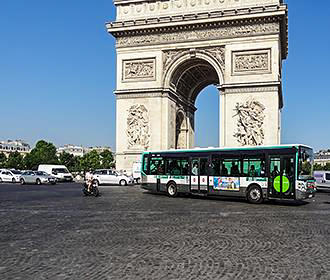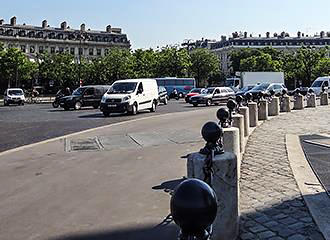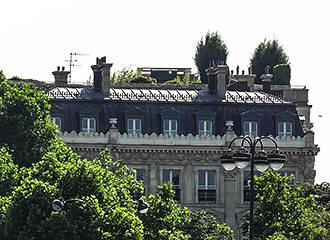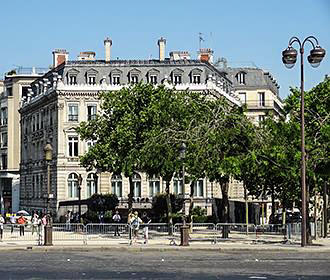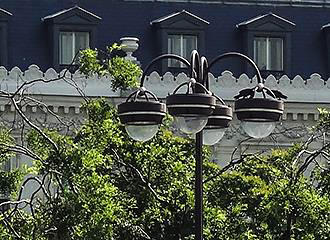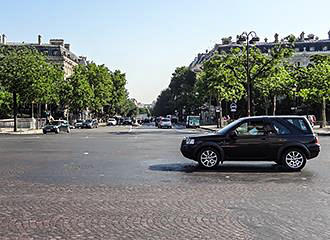Place Charles de Gaulle Square in Paris
The Place Charles de Gaulle is often known as the Place de l’Etoile or star square, which is due to the roads all intersecting this notorious junction, yet it is probably most famous for being the location of the Arc de Triomphe that is the famous large triumphal arch monument in Paris.
A bit of history
Originally the mound that was known as Roule Hill, which is now the square, was a point where several hunting trails converged and during the latter part of the 1700s roads were constructed and the paved area here formed a star like shape that can still be seen today.
The name chosen was Place de l’Etoile and etoile means star in English, which is rather apt considering there are twelve straight Avenues that all start from this square in Paris in a completely symmetrical pattern, and therefore when looking from above it is like the lights shining out from a star.
Then during the reign of Napoleon Bonaparte I, he commissioned a triumphal arch to be constructed, and the Place de l’Etoile at the centre of this square was chosen, as it was the most logical place for victory marches to start from going down the Champs Elysees.
Work for the arch, which was to be called the Arc de Triomphe, was first started in the August of 1806, yet unfortunately, Napoleon Bonaparte I never saw this monument in Paris completed as he died well before, and it was finally inaugurated in 1836 under the reign of King Louis Philippe.
However, you will still find the names of victories under Napoleons reign and then, after World War I, it was decided that there should be a memorial put in place to honour those that fought for France. Although thoughts first turned to The Pantheon, which is a famous burial place in Paris, it was decided that a tomb of an Unknown Soldier should be placed underneath the Arc de Triomphe. Then another idea came about for there to be an eternal flame to be put in place as well, which in fact is relit in a ceremony every evening.
General Charles de Gaulle re-lit the flame himself on the occasion of the victory parade and speech he gave after the Liberation of Paris in World War II, and upon the death of General Charles Gaulle in 1970, the square was renamed the Place Charles de Gaulle in his honour, even though many people still refer to it as the Place de l’Etoile or as the Place Charles de Gaulle - Etoile.
About Place Charles de Gaulle today
As we mentioned above there are actually twelve avenues that all converge on this square in Paris, which has become notorious for its accidents and there are apparently some insurance companies that will not cover you while driving round it!
Yet very few of the avenues have the same name as they started out with except for the Avenue d’Iena and the most famous of all the avenues, which is the Avenue des Champs Elysees.
And during the Second Empire many of the streets were renamed and one was originally called the Boulevard Bezons or the Boulevard de l’Etoile, which was renamed the Avenue de Wagram and another was called Boulevard Beaujon that was renamed the Avenue de Friedland.
A further three were renamed during the Second Empire to their current names, which are the Avenue de la Grande-Armee that was formerly the Avenue de Neuilly, the original Avenue du Prince-Jerome is now the Avenue Mac-Mahon and the Avenue d’Essling is now called the Avenue Carnot.
However some have changed names even more like the Boulevard de Passy, which changed to the Avenue du Roi-de-Rome and then to current street name of Avenue Kleber. This is the same for the Boulevard Monceau that changed to Avenue de la Reine-Hortense and then to its current name of Avenue Hoche, along with the original Avenue de l’Imperatrice that changed to the Avenue du Bois, which is now known as the Avenue Foch. Yet another that had the same fate was the original Avenue Saint-Cloud that was changed to the Avenue d’Eylau and finally it was changed again to its current name of Avenue Victor Hugo, after the famous novelist who wrote the Hunchback of Notre Dame.
We also mentioned earlier that the Place Charles de Gaulle square in Paris is symmetrical and each of these Avenues is on an axis with another, but the historical axis with the Avenue des Champs Elysees and the Avenue de la Grande-Armee. And today this historical axis goes all the way from the Grande Arche in the Defense area to the Arc de Triomphe at the former Place de l’Etoile square along the Champs Elysees to the Place de la Concorde with the Luxor Obelisk, the Tuileries Gardens and on to the famous museum in Paris called The Louvre.
Visiting Place Charles de Gaulle in Paris
Now after having read about the amount of different avenues that all converge on the Place Charles de Gaulle, you can probably appreciate that there is actually no pedestrian access to the square by crossing any of these intersections, and please do not attempt it, it is far too dangerous and sheer stupidity for anyone to try, as this is one of the largest intersections in the world.
So, how do you get to visit the famous Arc de Triomphe? Well, you will be pleased to know that there is an underground tunnel for pedestrians to visit this famous monument in Paris, and you would need to get off at the Metro station called Charles de Gaulle - Etoile via lines 1, 2 or 6 or the RER via line A.
You will find the passage located at the Wagram exit of the metro station on the Avenue de la Grande Armee, yet there is also a passage on the Champs-Elysees side as well, although you can also access a passage from the Avenue des Champs-Elysees.
But there are also the Paris buses numbered 22, 30, 31, 52, 73, 92 and 341 along with the Noctilien night bus service via lines N11, N24, N53, N151 and N153 that will get you close by to the underground tunnels in order to access the Place Charles de Gaulle, and its impressive tourist attraction of the Arc de Triomphe and its museum, but not forgetting the fabulous views you can get from going up to the top of this triumphal arch.
There are of course additional options such as sightseeing tour buses along with taxis and Paris airport shuttle bus services that can get you to or from this famous monument, and if you wish, you can look at the how to get the Arc de Triomphe page on our website that provides in-depth details of all of these including maps, timetables, a visitors guide, etc.
